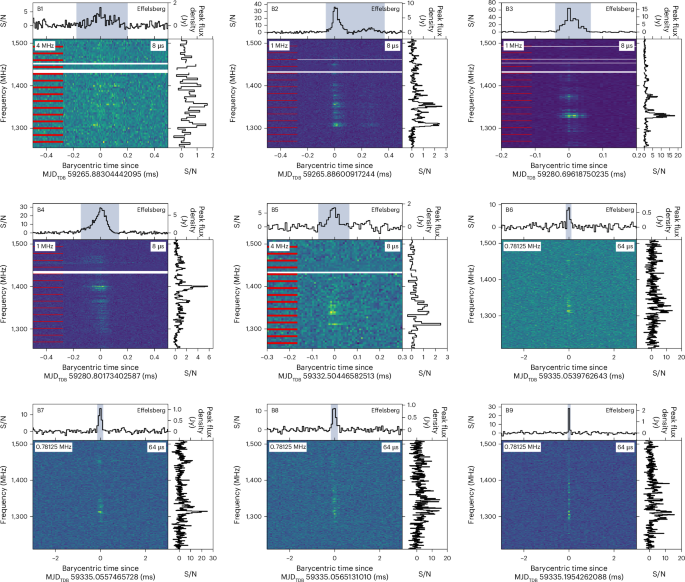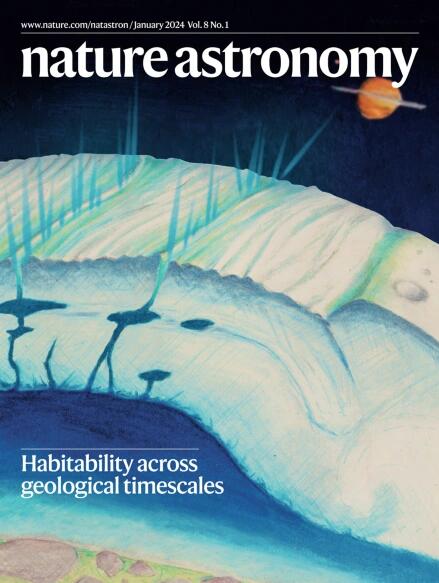Multiwavelength constraints on the origin of a nearby repeating fast radio burst source in a globular cluster
IF 12.9
1区 物理与天体物理
Q1 ASTRONOMY & ASTROPHYSICS
引用次数: 0
Abstract
The precise origins of fast radio bursts (FRBs) remain unknown. Multiwavelength observations of nearby FRB sources can provide important insights into the enigmatic FRB phenomenon. Here we present results from a sensitive, broadband X-ray and radio observational campaign of FRB 20200120E, the closest known extragalactic repeating FRB source (located 3.63 Mpc away in an ~10-Gyr-old globular cluster). We place deep limits on the persistent and prompt X-ray emission from FRB 20200120E, which we use to constrain possible origins for the source. We compare our results with various classes of X-ray sources, transients and FRB models. We find that FRB 20200120E is unlikely to be associated with ultraluminous X-ray bursts, magnetar-like giant flares or an SGR 1935+2154-like intermediate flare. Although other types of bright magnetar-like intermediate flares and short X-ray bursts would have been detectable from FRB 20200120E during our observations, we cannot entirely rule them out as a class. We show that FRB 20200120E is unlikely to be powered by an ultraluminous X-ray source or a young extragalactic pulsar embedded in a Crab-like nebula. We also provide new constraints on the compatibility of FRB 20200120E with accretion-based FRB models involving X-ray binaries. These results highlight the power of multiwavelength observations of nearby FRBs for discriminating between FRB models. Deep X-ray limits are placed on the source of the closest fast radio burst, FRB 20200120E, ruling out an ultraluminous X-ray source or a young extragalactic pulsar embedded in a Crab-like nebula as its origin.


对球状星团中邻近重复快速射电暴源起源的多波长约束
快速射电暴(FRB)的确切起源仍然未知。对邻近的快速射电暴源进行多波长观测,可以为研究神秘的快速射电暴现象提供重要的启示。在这里,我们展示了对FRB 20200120E的敏感、宽带X射线和无线电观测活动的结果,FRB 20200120E是已知最接近的银河系外重复FRB源(位于3.63 Mpc外的一个~10-Gyr-龄的球状星团中)。我们对 FRB 20200120E 的持续和快速 X 射线发射进行了深度限制,并以此来约束该源的可能起源。我们将我们的结果与各类 X 射线源、瞬态和 FRB 模型进行了比较。我们发现FRB 20200120E不太可能与超高亮X射线暴、类磁星巨耀或类似SGR 1935+2154的中间耀斑有关。尽管在我们的观测过程中,FRB 20200120E 还可以探测到其他类型的类磁星中间耀斑和短 X 射线暴,但我们不能完全排除它们的存在。我们的观测结果表明,FRB 20200120E 不太可能是由一个超高亮 X 射线源或一颗嵌入蟹状星云的年轻河外脉冲星驱动的。我们还为FRB 20200120E与涉及X射线双星的基于吸积的FRB模型的兼容性提供了新的约束条件。这些结果凸显了对附近FRB的多波长观测在区分FRB模型方面的威力。
本文章由计算机程序翻译,如有差异,请以英文原文为准。
求助全文
约1分钟内获得全文
求助全文
来源期刊

Nature Astronomy
Physics and Astronomy-Astronomy and Astrophysics
CiteScore
19.50
自引率
2.80%
发文量
252
期刊介绍:
Nature Astronomy, the oldest science, has played a significant role in the history of Nature. Throughout the years, pioneering discoveries such as the first quasar, exoplanet, and understanding of spiral nebulae have been reported in the journal. With the introduction of Nature Astronomy, the field now receives expanded coverage, welcoming research in astronomy, astrophysics, and planetary science. The primary objective is to encourage closer collaboration among researchers in these related areas.
Similar to other journals under the Nature brand, Nature Astronomy boasts a devoted team of professional editors, ensuring fairness and rigorous peer-review processes. The journal maintains high standards in copy-editing and production, ensuring timely publication and editorial independence.
In addition to original research, Nature Astronomy publishes a wide range of content, including Comments, Reviews, News and Views, Features, and Correspondence. This diverse collection covers various disciplines within astronomy and includes contributions from a diverse range of voices.
 求助内容:
求助内容: 应助结果提醒方式:
应助结果提醒方式:


